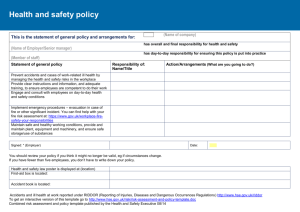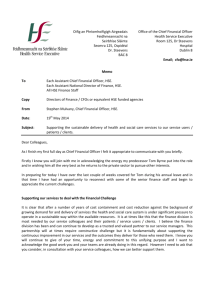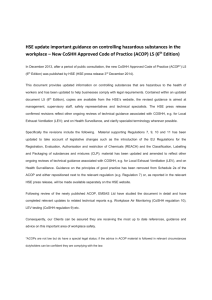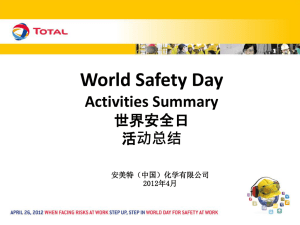Health risks during furniture stripping using dichloromethane
advertisement
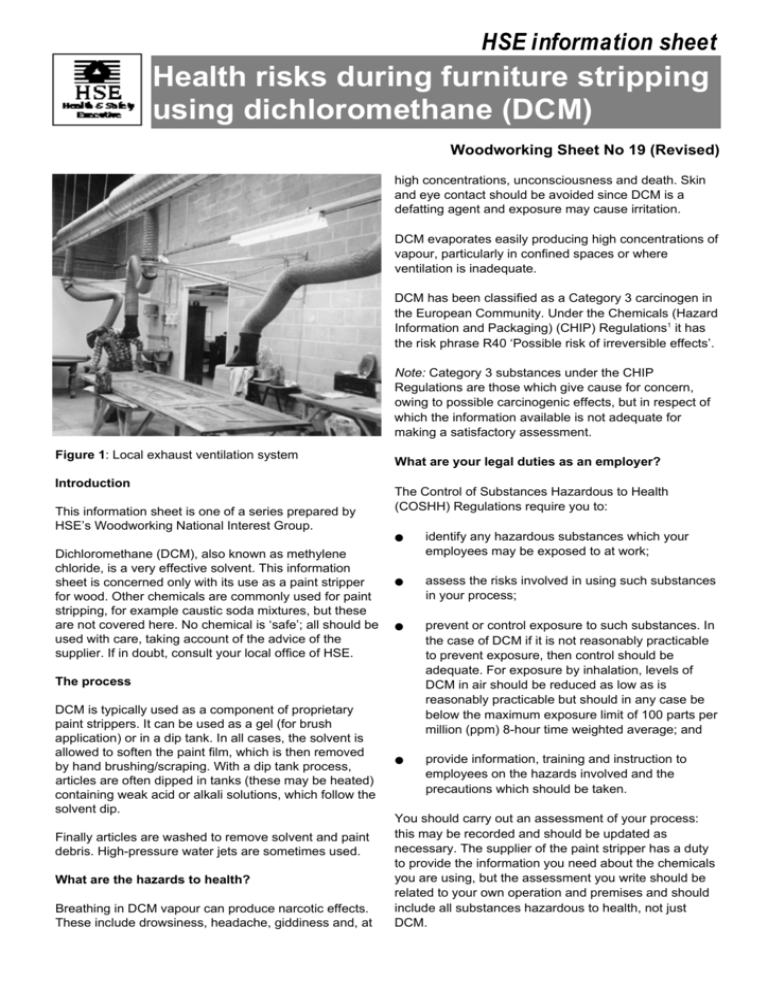
HSE information sheet Health risks during furniture stripping using dichloromethane (DCM) Woodworking Sheet No 19 (Revised) high concentrations, unconsciousness and death. Skin and eye contact should be avoided since DCM is a defatting agent and exposure may cause irritation. DCM evaporates easily producing high concentrations of vapour, particularly in confined spaces or where ventilation is inadequate. DCM has been classified as a Category 3 carcinogen in the European Community. Under the Chemicals (Hazard Information and Packaging) (CHIP) Regulations1 it has the risk phrase R40 ‘Possible risk of irreversible effects’. Note: Category 3 substances under the CHIP Regulations are those which give cause for concern, owing to possible carcinogenic effects, but in respect of which the information available is not adequate for making a satisfactory assessment. Figure 1: Local exhaust ventilation system Introduction This information sheet is one of a series prepared by HSE’s Woodworking National Interest Group. Dichloromethane (DCM), also known as methylene chloride, is a very effective solvent. This information sheet is concerned only with its use as a paint stripper for wood. Other chemicals are commonly used for paint stripping, for example caustic soda mixtures, but these are not covered here. No chemical is ‘safe’; all should be used with care, taking account of the advice of the supplier. If in doubt, consult your local office of HSE. What are your legal duties as an employer? The Control of Substances Hazardous to Health (COSHH) Regulations require you to: ● identify any hazardous substances which your employees may be exposed to at work; ● assess the risks involved in using such substances in your process; ● prevent or control exposure to such substances. In the case of DCM if it is not reasonably practicable to prevent exposure, then control should be adequate. For exposure by inhalation, levels of DCM in air should be reduced as low as is reasonably practicable but should in any case be below the maximum exposure limit of 100 parts per million (ppm) 8-hour time weighted average; and ● provide information, training and instruction to employees on the hazards involved and the precautions which should be taken. The process DCM is typically used as a component of proprietary paint strippers. It can be used as a gel (for brush application) or in a dip tank. In all cases, the solvent is allowed to soften the paint film, which is then removed by hand brushing/scraping. With a dip tank process, articles are often dipped in tanks (these may be heated) containing weak acid or alkali solutions, which follow the solvent dip. Finally articles are washed to remove solvent and paint debris. High-pressure water jets are sometimes used. What are the hazards to health? Breathing in DCM vapour can produce narcotic effects. These include drowsiness, headache, giddiness and, at You should carry out an assessment of your process: this may be recorded and should be updated as necessary. The supplier of the paint stripper has a duty to provide the information you need about the chemicals you are using, but the assessment you write should be related to your own operation and premises and should include all substances hazardous to health, not just DCM. Figure 2: Dipping tank for furniture stripping This sheet cannot give you all the information you need about the general requirements of the COSHH Regulations, but HSE has published other guidance.2, 3, 4, 5 and 6 Preventing exposure You can prevent exposure by choosing a paint stripper which does not contain DCM or by using a ʻnonchemicalʼ method, for example abrasion. However, any chemical which will dissolve a paint film is likely to have an effect on health. These effects may be less well known than those associated with DCM, which has been widely studied. Controlling exposure Surveys have shown that good working practices can reduce exposure levels significantly. A series of measures will be needed, the most important of which is a well-designed ventilation system, including good general ventilation. However, working methods are also crucial as the effect of, for example, lip extraction can be lost if work is done outside the influence of the local exhaust ventilation (LEV). Absorption through the skin can be controlled by good working methods and protective clothing. Brush application Ventilation - Provide good general ventilation (using mechanical fans) and LEV (unless work is infrequent/ WELL DESIGNED VENTILATION (GENERAL AND/OR LOCAL) + GOOD WORKING METHODS SUITABLE + PROTECTIVE EQUIPMENT CONTROL OF EXPOSURE intermittent). Small articles could be stripped in a simple purpose-built booth; large articles in a spray booth if one is available. A local exhaust ventilation system is illustrated in Figure 1. Working methods - Reduce area of exposed gel to the minimum. Keep solvent cans closed and use spill- resistant containers. Keep solvent-contaminated rags/wipes and waste in closed containers. exceed the current short-term guidance value of 250 ppm over any 10 minute period. Dip tank This should be either: Ventilation - All tanks should be fitted with effective LEV.7,8 General mechanical ventilation should be installed to provide make up air. This should be designed to operate in conjunction with LEV at the tanks. Where possible, a separate ventilated area should be set aside for drying finished articles. Control in the dipping area will also be improved by enclosing the sides and top of the tank (see Figure 2). ● a full face mask to EN136 or BS7355 (type approved) with a type approved AX canister suitable for use with DCM; or ● compressed air supplied equipment. A lightweight air-fed visor may be suitable (check with your equipment supplier that it is suitable for use with DCM). Working methods - The bath layout should be designed to minimise transfer distances and to allow a linear path through the process. If possible, mechanical lifting gear and workpiece support should be provided for workpiece transfer. When a compressor is used as the source of supply for breathing air, special considerations are necessary to ensure adequate air supplies of acceptable quality.10 Long-handled tools should be used for scraping and bath cleaning. All solvent wet items should be stored within the influence of the LEV or in closed containers which can be opened within the influence of the LEV. Tools should be provided with drip guards. You will need to measure solvent vapour in air: A simple pump or syphon system should be used to replenish the bath and to flow stripper over workpieces in the bath so that the operator need not reach into the tank to bale solvent over workpieces. Only one person should work at the stripping bath at a time, minimising solvent disturbance. Heated wash tanks which follow the solvent tank should be kept at the lowest suitable temperature to limit solvent flash-off. All tanks should be covered when not in use. To avoid high continuous exposures, workers should not spend all their time on one stage of the process. No one should work alone in an immersion stripping workshop. There should always be someone close by who is able to give assistance in an emergency. Protective equipment for employees Personal protective equipment should be provided and worn as required by the Personal Protective Equipment at Work Regulations 1992.9 The minimum protective equipment requirements for anyone working with DCM are impermeable overalls, apron, footwear, long gloves and gauntlets and chemically resistant goggles or visor. Your supplier will advise on materials suitable for use with DCM. In addition, respiratory protective equipment is required unless it can be demonstrated that exposure is below the maximum exposure limit of 100 ppm and does not Air sampling ● to show that your control measures are effective; ● to decide whether or not you need to provide respiratory protective equipment. Are your customers at risk? Freshly stripped items which are not properly aired and are then carried in a closed vehicle could present a risk. Children are more vulnerable to the effects of solvent vapour than adults. Do not allow customers to take home freshly treated articles, especially furniture with cupboards or drawers, which are difficult to air and items with a lot of filler which can absorb solvent. Other risks you should consider When DCM burns it produces corrosive and toxic vapours. Smoking should be prohibited in areas where DCM is used and the stripping area should be free from other sources of ignition. Formulated products based on DCM may also contain other compounds which may be hazardous themselves. Remember, DCM vapour is almost three times as heavy as air and will accumulate at low levels. Dealing with spills Any spillage should be dealt with immediately. Small spills can be treated with absorbent material such as vermiculite. Contaminated material should be stored in closed containers until it can be disposed of. You should have a formal procedure for dealing with larger spills, including evacuation as necessary. Ask your DCM supplier to advise you. All employees should be trained in the procedure, which should be written down and clearly displayed in the workroom. 6 COSHH and the woodworking industries Woodworking Information Sheet WIS6(rev) HSE Books 1997 7 An introduction to local exhaust ventilation HSG37 HSE Books 1993 ISBN 0 7176 1001 2 Welfare facilities Eating, drinking and smoking should not be allowed in a workroom where solvents are used. A separate designated area should be provided. Accommodation for employees’ clothing and for protective clothing not in use will be needed. Respiratory protective equipment should be kept in a clean, dry place where it will not become contaminated. Washing and toilet facilities should be provided to the standards required by the Workplace (Health, Safety and Welfare) Regulations 1992.11 Reading list and references 1 Chemicals (Hazard Information and Packaging) Regulations 1994 (as amended) Safety data sheets for substances and preparations dangerous for supply Approved Code of Practice L62 HSE Books 1995 ISBN 0 7176 0859 X Approved guide to the classification and labelling of substances and preparations dangerous for supply L100 HSE Books 1997 ISBN 0 7176 1366 6 Information approved for the classification and labelling of substances and preparations dangerous for supply Approved supply list L115 HSE Books 1999 ISBN 0 7176 1725 4 2 General COSHH ACOP, Carcinogens ACOP and Biological Agents ACOP. Control of Substances Hazardous to Health Regulations 1999 Approved Codes of Practice HSE Books 1999 ISBN 0 7176 1670 3 3 A step-by-step guide to COSHH assessment HSG97 HSE Books 1993 ISBN 0 7176 1446 8 4 EH40 Occupational exposure limits Guidance Note EH40 HSE Books (revised annually) 5 Health surveillance under COSHH: guidance for employers HSE Books 1990 ISBN 0 7176 0491 8 Printed and published by the Health and Safety Executive 8 The maintenance, examination and testing of local exhaust ventilation HSG54 HSE Books 1998 ISBN 0 7176 1485 9 9 Personal Protective Equipment at Work Regulations 1992: Guidance on Regulations L25 HSE Books 1992 ISBN 0 7176 0415 2 10 The selection, use and maintenance of respiratory protective equipment: A practical guide HSG53 HSE Books 1998 ISBN 0 7176 1537 5 11 Workplace health, safety and welfare. Workplace (Health, Safety and Welfare) Regulations 1992. Approved Code of Practice and guidance L24 HSE Books 1992 ISBN 0 7176 0413 6 12 Essentials of health and safety at work HSE Books 1994 ISBN 0 7176 0716 X 13 Working safely with solvents: A guide to safe working practices INDG273 HSE Books 1998 Further information HSE priced and free publications are available by mail order from HSE Books, PO Box 1999, Sudbury, Suffolk CO10 2WA Tel: 01787 881165 Fax: 01787 313995 Website: www.hsebooks.co.uk (HSE priced publications are also available from bookshops.) For information about health and safety ring HSE's InfoLine Tel: 08701 545500 Fax: 02920 859260 e-mail: hseinformationservices@natbrit.com or write to HSE Information Services, Caerphilly Business Park, Caerphilly CF83 3GG. You can also visit HSE’s website: www.hse.gov.uk This leaflet contains notes on good practice which are not compulsory but which you may find helpful in considering what you need to do. This publication may be freely reproduced, except for advertising, endorsement or commercial purposes. The information is current at 7/93. Please acknowledge the source as HSE. 6/01 WIS19 C30

